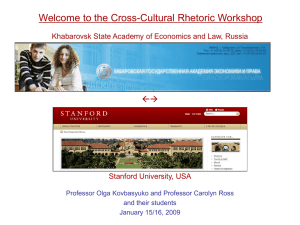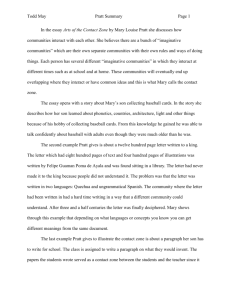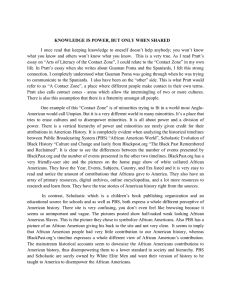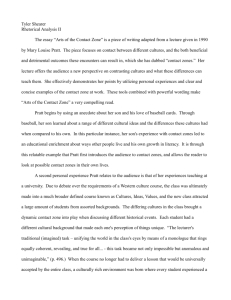Reading/Thinking Questions for Pratt, "Arts of the Contact Zone"
advertisement
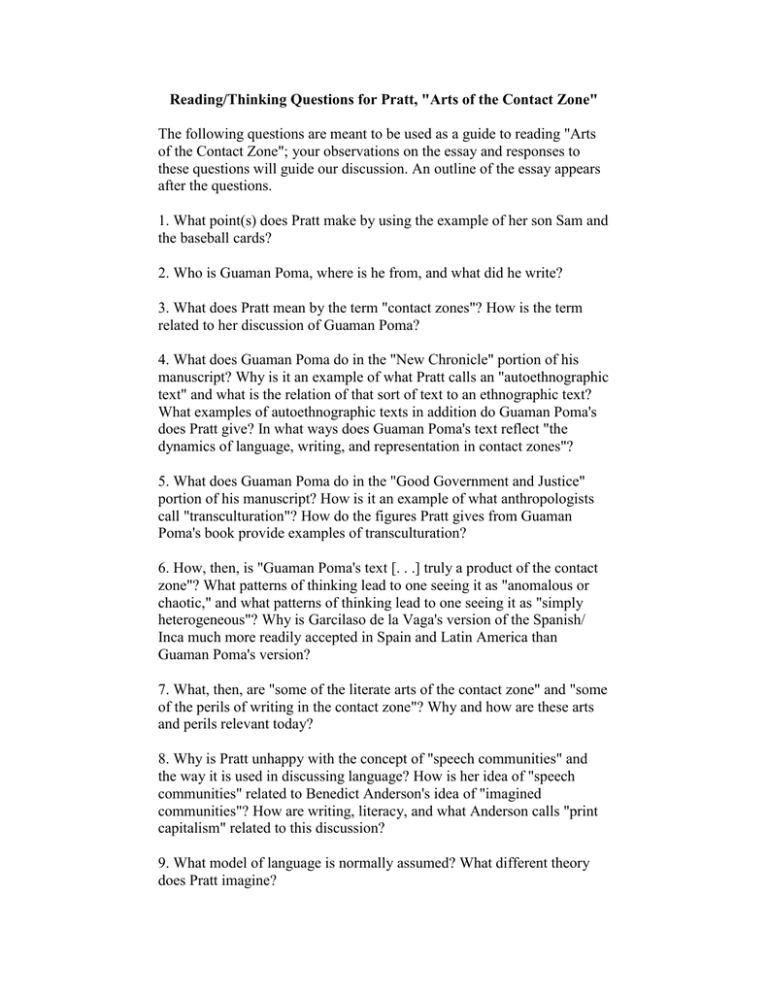
Reading/Thinking Questions for Pratt, "Arts of the Contact Zone" The following questions are meant to be used as a guide to reading "Arts of the Contact Zone"; your observations on the essay and responses to these questions will guide our discussion. An outline of the essay appears after the questions. 1. What point(s) does Pratt make by using the example of her son Sam and the baseball cards? 2. Who is Guaman Poma, where is he from, and what did he write? 3. What does Pratt mean by the term "contact zones"? How is the term related to her discussion of Guaman Poma? 4. What does Guaman Poma do in the "New Chronicle" portion of his manuscript? Why is it an example of what Pratt calls an "autoethnographic text" and what is the relation of that sort of text to an ethnographic text? What examples of autoethnographic texts in addition do Guaman Poma's does Pratt give? In what ways does Guaman Poma's text reflect "the dynamics of language, writing, and representation in contact zones"? 5. What does Guaman Poma do in the "Good Government and Justice" portion of his manuscript? How is it an example of what anthropologists call "transculturation"? How do the figures Pratt gives from Guaman Poma's book provide examples of transculturation? 6. How, then, is "Guaman Poma's text [. . .] truly a product of the contact zone"? What patterns of thinking lead to one seeing it as "anomalous or chaotic," and what patterns of thinking lead to one seeing it as "simply heterogeneous"? Why is Garcilaso de la Vaga's version of the Spanish/ Inca much more readily accepted in Spain and Latin America than Guaman Poma's version? 7. What, then, are "some of the literate arts of the contact zone" and "some of the perils of writing in the contact zone"? Why and how are these arts and perils relevant today? 8. Why is Pratt unhappy with the concept of "speech communities" and the way it is used in discussing language? How is her idea of "speech communities" related to Benedict Anderson's idea of "imagined communities"? How are writing, literacy, and what Anderson calls "print capitalism" related to this discussion? 9. What model of language is normally assumed? What different theory does Pratt imagine? 10. What are the assumptions of the analyses of language based on the "autonomous, fraternal models of community" overlook? Why might this model not work "when speakers are from different classes or cultures, or one party is exercising authority and another is submitting to it or questioning it"? How does Pratt use the two examples involving her son (Manuel this time) to develop this part of the discussion? 11. Why is this discussion of contact zones important for the United States in the 1990s (note the date of her essay)? How does she use the experience of the Stanford course in “Cultures, Ideas, Values” to raise issues involving "the pedagogical arts of the contact zone"? What examples of these arts does she give? Why are what she calls "safe houses" and programs like ethnic and women's studies still needed? 12. Jot down two questions you would ask Pratt after reading her essay. Outline I. Introduction: new visions of literacy A. B. II. Literacy through baseball cards and baseball: Pratt's son Sam Schooling gave him the tools but nothing to take him beyond baseball Phenomena of literacy in the contact zones A. B. Reading an "unreadable" text: Guaman Poma's New Chronicle and Good Government in the twentieth century Writing and literacy in the contact zones. 1. 2. C. Reading differently in the contact zone. 1. 2. 3. D. Guaman Poma's text as autoethnography Guaman Poma's text as an example of transculturation Literate bilingual audience in the Andes in the early 1600s produces Guaman Poma's text Monolingual colonialist audience in Spain fails to read Guaman Poma's text but is able to produce and read Garcilaso de la Vega's Royal Commentaries of the Incas. Transcultural currents of expression have continued to evolve in the Andes Both the literate arts of the contact zone and the perils of writing in the contact zone are with us in the US today and becoming more visible, more pressing, and more decipherable. III. Language in communities and in contact zones A. The utopian sense of language in current thinking about speech communities 1. Imagined communities (Benedict Anderson) 2. B. Normative assumptions of unified and homogeneous speech communities and so unified and homogeneous social worlds Imagining a different theory of language situations 1. 2. A normative situation not of people who all spoke the same language but of people who spoke two languages and understood a third and who held only one language in common with any of the others Using language to resist or subvert the interests of those in power and who therefore define what is normative a. b. C. Pratt's son Manuel reacts to a new school Manuel resists or subverts school assignments but like Guaman Poma is not heard In the US today we see the rise of autonomous social groups disputing the dominant institutions 1. 2. 3. Rhetorics of diversity and multiculturalism The idea of educational democracy The debate over the Stanford course IV. Conclusion: Teaching and learning in the contact zone A. B. C. In the contact zone: teaching the Stanford course The continuing need for community: safe houses in the Stanford course Looking for the pedagogical arts of the contact zone
